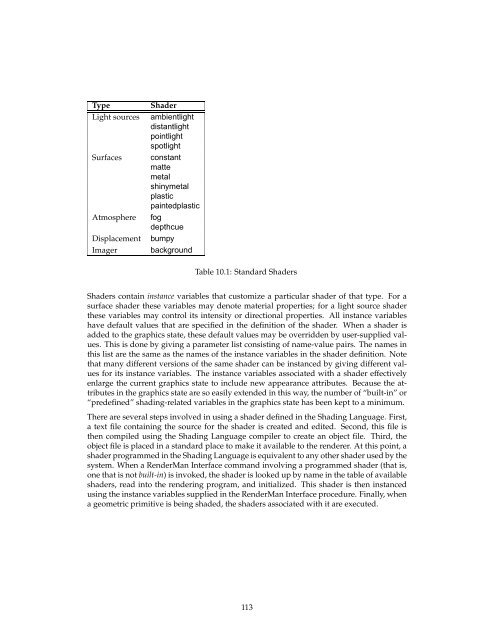The RenderMan Interface - Paul Bourke
The RenderMan Interface - Paul Bourke
The RenderMan Interface - Paul Bourke
- No tags were found...
You also want an ePaper? Increase the reach of your titles
YUMPU automatically turns print PDFs into web optimized ePapers that Google loves.
Type<br />
Light sources<br />
Surfaces<br />
Atmosphere<br />
Displacement<br />
Imager<br />
Shader<br />
ambientlight<br />
distantlight<br />
pointlight<br />
spotlight<br />
constant<br />
matte<br />
metal<br />
shinymetal<br />
plastic<br />
paintedplastic<br />
fog<br />
depthcue<br />
bumpy<br />
background<br />
Table 10.1: Standard Shaders<br />
Shaders contain instance variables that customize a particular shader of that type. For a<br />
surface shader these variables may denote material properties; for a light source shader<br />
these variables may control its intensity or directional properties. All instance variables<br />
have default values that are specified in the definition of the shader. When a shader is<br />
added to the graphics state, these default values may be overridden by user-supplied values.<br />
This is done by giving a parameter list consisting of name-value pairs. <strong>The</strong> names in<br />
this list are the same as the names of the instance variables in the shader definition. Note<br />
that many different versions of the same shader can be instanced by giving different values<br />
for its instance variables. <strong>The</strong> instance variables associated with a shader effectively<br />
enlarge the current graphics state to include new appearance attributes. Because the attributes<br />
in the graphics state are so easily extended in this way, the number of “built-in” or<br />
“predefined” shading-related variables in the graphics state has been kept to a minimum.<br />
<strong>The</strong>re are several steps involved in using a shader defined in the Shading Language. First,<br />
a text file containing the source for the shader is created and edited. Second, this file is<br />
then compiled using the Shading Language compiler to create an object file. Third, the<br />
object file is placed in a standard place to make it available to the renderer. At this point, a<br />
shader programmed in the Shading Language is equivalent to any other shader used by the<br />
system. When a <strong>RenderMan</strong> <strong>Interface</strong> command involving a programmed shader (that is,<br />
one that is not built-in) is invoked, the shader is looked up by name in the table of available<br />
shaders, read into the rendering program, and initialized. This shader is then instanced<br />
using the instance variables supplied in the <strong>RenderMan</strong> <strong>Interface</strong> procedure. Finally, when<br />
a geometric primitive is being shaded, the shaders associated with it are executed.<br />
113















